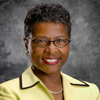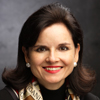MBAs in the Field
Consulting Class Emphasizes Real-World Learning
By Cathy Wilde
Professor Nick Everest's "Consulting Practices" graduate class is all about "keeping it real."
Real clients. Real issues. Real solutions.
Rather than teaching from a textbook, Everest, an assistant professor of organization and human resources and practicing consultant, has his MBA students learn by serving as consultants themselves.
The emphasis on real-world learning is present from the start, Everest says. Students are not assigned projects, but must go out and find clients on their own. Sometimes, Everest is aware of a client's needs and may steer a team in that direction, but, he stresses, the final decision to commit to a project rests entirely with the students.

"[The students] conducted themselves with the utmost professionalism both in their interactions with our staff and in fulfilling the terms of our contract."
Tina Stenhouse,
Moog Inc.
Other times, a company may contact Everest to request help with an issue, due to the good reputation the consulting class has developed in the local community. Such was the case with Moog Inc., whose corporate group human resources director, Tina Stenhouse, reached out to Everest for help in finding ways to promote, enhance and maintain the company's corporate culture.
"I sought to gain a fresh perspective on our culture and I was looking for input on what activities, events, systems or processes work and which don't," Stenhouse says.
Javier Sullivan, MBA '10, was a member of the consulting team for Moog, which met with various groups of employees to learn about the culture and discern where there might be gaps between the human resource department's goals and what was actually occurring in the workplace.
The group came up with a number of recommendations, including more interaction with Moog retirees to pass on the culture to current employees; revamping new employee orientation; conducting cultural surveys to assess whether everyone is on the same page; and creating a wiki-type knowledge center they dubbed "Moogopedia."

"We learned how to work together while using our individual strengths and expertise to their fullest."
Britt Bird,
MBA '10
Sullivan says one of the highlights of the experience was presenting their ideas to several top executives at Moog, including the chief administrative officer, the chief financial officer and the vice president and chief human resources officer.
Stenhouse was very impressed with Sullivan and his team. "They conducted themselves with the utmost professionalism both in their interactions with our staff and in fulfilling the terms of our contract," she says. "We are planning to integrate the 'Moogopedia' idea into a business networking project we have already under way, and are considering several of their other recommendations."
Another consulting team worked with a nonprofit organization, the Community Foundation for Greater Buffalo, a public charity that holds more than 800 different charitable funds to help benefit Western New York.
The foundation often is called upon to put organizations in touch with each other to address issues. They were seeking a way to track, evaluate and analyze the connections they made in order to measure the foundation's impact on the community.

"[The MBAs] were open to feedback throughout the process and exceeded expectations based on what they had promised."
Clotilde Perez-Bode Dedecker,
Community Foundation for Greater Buffalo
The team devised a web-based program, Connection Tracker, that quantifies the collaborations between the groups by tallying the total number of partnerships established, people helped and grant dollars leveraged as a result of the foundation's efforts.
"The system will provide us with a comprehensive picture of our impact," says Clotilde Perez-Bode Dedecker, president and CEO of the foundation. "This information will help us in the future to guide and invest our donors' dollars in programs that yield the highest impact, help the most people and make the biggest changes."
Dedecker says the foundation couldn't be more pleased with the project. "The team operated very professionally," she says. "They really listened to what our needs and goals were and then worked to develop a feasible solution to address those points. They were open to feedback throughout the process and exceeded expectations based on what they had promised."
In fact, Dedecker calls Connection Tracker a "pioneer effort" in the foundation field. "Many foundations struggle with how to record and report impact," she says. "If this system works as designed, it will be a best practice we can share with our peers around the country."

"We found it was really important to define expectations."
Javier Sullivan,
MBA '10
Throughout the semester, Everest evaluates the consulting teams on the presentations they make to their clients and on summaries they submit to him. "The thread of learning throughout the class includes the consulting process and its essential skills, the industry they're working with, working in teams and even learning about themselves," Everest says.
Sullivan says one of the primary learning experiences was in managing the client. "We found it was really important to define expectations, such as the breadth of data collection, the specific deliverables and how often there would be contact between the team and client," he says.
Britt Bird, MBA '10, a senior marketing associate at Fisher-Price, was a member of the Community Foundation team. She says managing expectations was also a key aspect of her team's experience. "We learned how to negotiate the terms of the consulting contract to provide value for the client while remaining realistic about the scope of the project," she says. "We definitely overdelivered in some areas, but also managed the client's expectations so we didn't take on substantially more than was originally agreed upon in the contract."
Sullivan and Bird each stated that learning how to manage a team proved to be very valuable to them personally. They both faced the task of determining which project responsibilities best matched each group member's capabilities. Ultimately, Bird says of her team, "We learned how to work together while using our individual strengths and expertise to their fullest."
What it all comes down to, Sullivan says, is learning how to manage relationships. "Those skills are transferable in any business situation," he says.
